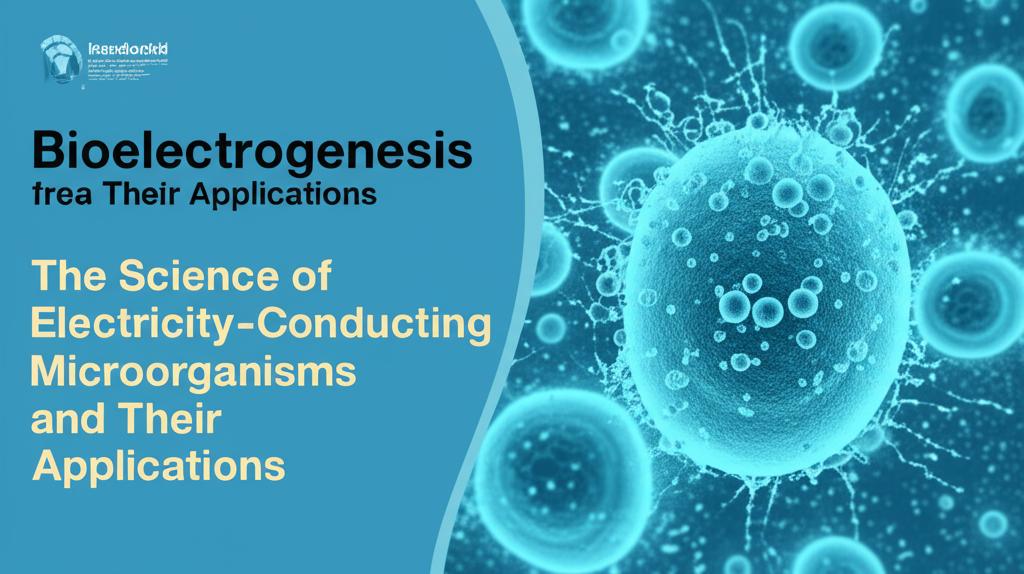The fascinating world of bioelectrogenesis revolves around microorganisms capable of generating electricity. These electroactive bacteria (EAB) or electricigens possess unique metabolic pathways that allow them to transfer electrons to external solid-state electrodes, producing an electrical current. This remarkable ability opens doors to a wide array of applications, from renewable energy generation to environmental remediation.
Mechanisms of Bioelectrogenesis:Electroactive bacteria employ specialized redox circuitry that extends outside their cells to transfer electrons. This extracellular electron transfer (EET) can occur through a few primary mechanisms:
- Direct Electron Transfer (DET): Some bacteria can directly transfer electrons from their cell membranes to an electrode via outer-membrane proteins or conductive "nanowires."
- Mediated Electron Transfer (MET): Other bacteria release soluble molecules, known as electron shuttles or mediators (e.g., flavins or phenazine compounds), which pick up electrons from the cell and transport them to the electrode.
- Direct Interspecies Electron Transfer (DIET): In some microbial communities, electrons can be directly transferred between different species of bacteria.
One of the most significant applications of bioelectrogenesis is in microbial fuel cells (MFCs). MFCs are bioelectrochemical devices that convert the chemical energy stored in organic matter directly into electrical energy through the metabolic activity of electrogenic bacteria.
A typical MFC consists of:
- Anode Chamber: This is where electroactive bacteria reside, often as a biofilm on the anode surface. They oxidize organic matter (the "fuel"), releasing electrons and protons.
- Cathode Chamber: Electrons flow from the anode through an external circuit to the cathode. Here, they combine with protons (that have migrated from the anode, often through a proton exchange membrane) and an electron acceptor (commonly oxygen) to form a reduced compound, like water.
- Proton Exchange Membrane (PEM) or Separator: This component facilitates the movement of protons from the anode to the cathode while keeping the fuel and the electron acceptor separate. Some MFC designs are membrane-less.
Research in bioelectrogenesis and MFC technology is rapidly evolving, with exciting new discoveries and applications emerging:
- Wastewater Treatment and Bioremediation: MFCs are highly effective in treating wastewater by using the organic pollutants as fuel, simultaneously generating electricity. They can remove organic compounds, nutrients, and even heavy metals. Soil and sediment MFCs are used for in-situ bioremediation of contaminated sites. Recent studies have demonstrated high removal efficiencies for chemical oxygen demand (COD), biochemical oxygen demand (BOD), and various pollutants using MFCs with specific bacterial consortia.
- Renewable Energy Generation: While the power output of individual MFCs is currently low, stacking multiple MFCs or coupling them with other systems like anaerobic digesters can increase energy production. They offer a sustainable way to generate electricity from diverse biodegradable organic waste sources, including agricultural residues and industrial effluents. Plant-MFCs (PMFCs) utilize organic matter released by plant roots, converting solar energy indirectly into electricity.
- Biosensors: MFCs can be adapted to function as biosensors for detecting pollutants, biochemical oxygen demand (BOD), or specific chemicals in water and soil. Their sensitivity to changes in the environment allows for real-time monitoring.
- Bioelectronics and "Green Electronics": The conductive nanowires produced by some electroactive bacteria, like Geobacter, are being explored for creating biodegradable electronic components. These "e-biologics" could reduce electronic waste and reliance on costly or toxic materials. Recent discoveries include new species of "cable bacteria," such as Ca. Electrothrix yaqonensis, which exhibit remarkable electrical conductivity along their filamentous structures, potentially inspiring novel bioelectronic devices. These bacteria have unique nickel-based molecules in their conductive fibers.
- Carbon Capture and Utilization: Microbial electrosynthesis (MES) is a related technology where microbes use electrons from a cathode to reduce carbon dioxide into valuable chemicals like methane, ethanol, or hydrogen, offering a pathway for carbon capture and conversion.
- Remote Power Supply: MFCs are being developed to power remote sensors and underwater monitoring devices, especially in locations where battery replacement is difficult or costly, as they can operate for extended periods using local resources.
- Enhanced Microbial Performance: Synthetic biology and genetic engineering techniques are being employed to enhance the electron transfer capabilities of native electroactive bacteria and even to introduce these pathways into well-understood organisms like E. coli. This allows for better control and increased efficiency in bioelectrochemical systems.
- Understanding Microbial Ecology: Research continues to uncover the diversity and complex interactions within electroactive microbial communities. Understanding how these consortia function is crucial for optimizing MFC performance. Studies are exploring the electroactivity spectrum, including "weak electricigens" that may play important roles in various environments.
- New Materials: Advances are being made in anode and cathode materials to improve biocompatibility, conductivity, and reduce costs. Carbon-based materials like graphite fibers and felts are common, and researchers are exploring novel composite materials.
Despite significant progress, several challenges remain in scaling up bioelectrogenesis technologies for widespread practical application:
- Low Power Density: Improving the power output and energy conversion efficiency of MFCs is a primary focus.
- Cost: The materials used in MFC construction, particularly for electrodes and membranes, can be expensive.
- Long-Term Stability and Scalability: Maintaining performance over long periods and effectively scaling up systems for industrial applications are ongoing challenges.
- Understanding Complex Microbial Interactions: Further research is needed to fully understand the intricate relationships within electroactive microbial communities to optimize their performance.
The field of bioelectrogenesis is dynamic and holds immense promise for sustainable solutions in energy, environmental management, and even medicine. Continued research and innovation in understanding these electrifying microbes and refining bioelectrochemical systems will be key to unlocking their full potential for a greener future.

